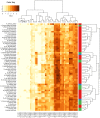Identification of polycomb repressive complex 1 and 2 core components in hexaploid bread wheat
- PMID: 33050875
- PMCID: PMC7557041
- DOI: 10.1186/s12870-020-02384-6
Identification of polycomb repressive complex 1 and 2 core components in hexaploid bread wheat
Erratum in
-
Publisher Correction to: BMC Plant Biology, Volume 20, supplement 1.BMC Plant Biol. 2021 Jan 15;21(1):43. doi: 10.1186/s12870-020-02802-9. BMC Plant Biol. 2021. PMID: 33451282 Free PMC article. No abstract available.
Abstract
Background: Polycomb repressive complexes 1 and 2 play important roles in epigenetic gene regulation by posttranslationally modifying specific histone residues. Polycomb repressive complex 2 is responsible for the trimethylation of lysine 27 on histone H3; Polycomb repressive complex 1 catalyzes the monoubiquitination of histone H2A at lysine 119. Both complexes have been thoroughly studied in Arabidopsis, but the evolution of polycomb group gene families in monocots, particularly those with complex allopolyploid origins, is unknown.
Results: Here, we present the in silico identification of the Polycomb repressive complex 1 and 2 (PRC2, PRC1) subunits in allohexaploid bread wheat, the reconstruction of their evolutionary history and a transcriptional analysis over a series of 33 developmental stages. We identified four main subunits of PRC2 [E(z), Su(z), FIE and MSI] and three main subunits of PRC1 (Pc, Psc and Sce) and determined their chromosomal locations. We found that most of the genes coding for subunit proteins are present as paralogs in bread wheat. Using bread wheat RNA-seq data from different tissues and developmental stages throughout plant ontogenesis revealed variable transcriptional activity for individual paralogs. Phylogenetic analysis showed a high level of protein conservation among temperate cereals.
Conclusions: The identification and chromosomal location of the Polycomb repressive complex 1 and 2 core components in bread wheat may enable a deeper understanding of developmental processes, including vernalization, in commonly grown winter wheat.
Keywords: Epigenetics; Histone methylation; PRC2; Polycomb repressive complex; Wheat.
Conflict of interest statement
The authors declare that they have no competing interests.
Figures




Similar articles
-
H2A Ubiquitination Alters H3-tail Dynamics on Linker-DNA to Enhance H3K27 Methylation.J Mol Biol. 2023 Feb 28;435(4):167936. doi: 10.1016/j.jmb.2022.167936. Epub 2023 Jan 4. J Mol Biol. 2023. PMID: 36610636
-
Conservation and diversification of polycomb repressive complex 2 (PRC2) proteins in the green lineage.Brief Funct Genomics. 2017 Mar 1;16(2):106-119. doi: 10.1093/bfgp/elw007. Brief Funct Genomics. 2017. PMID: 27032420
-
Evolution and conservation of polycomb repressive complex 1 core components and putative associated factors in the green lineage.BMC Genomics. 2019 Jun 28;20(1):533. doi: 10.1186/s12864-019-5905-9. BMC Genomics. 2019. PMID: 31253095 Free PMC article.
-
Critical Roles of Polycomb Repressive Complexes in Transcription and Cancer.Int J Mol Sci. 2022 Aug 24;23(17):9574. doi: 10.3390/ijms23179574. Int J Mol Sci. 2022. PMID: 36076977 Free PMC article. Review.
-
Activity of PRC1 and Histone H2AK119 Monoubiquitination: Revising Popular Misconceptions.Bioessays. 2020 May;42(5):e1900192. doi: 10.1002/bies.201900192. Epub 2020 Mar 20. Bioessays. 2020. PMID: 32196702 Free PMC article. Review.
Cited by
-
Genome-Wide Identification and Analysis of the Polycomb Group Family in Medicago truncatula.Int J Mol Sci. 2021 Jul 14;22(14):7537. doi: 10.3390/ijms22147537. Int J Mol Sci. 2021. PMID: 34299158 Free PMC article.
-
The transcriptome landscape of developing barley seeds.Plant Cell. 2024 Jul 2;36(7):2512-2530. doi: 10.1093/plcell/koae095. Plant Cell. 2024. PMID: 38635902
-
Transcript profiling of Polycomb gene family in Oryza sativa indicates their abiotic stress-specific response.Funct Integr Genomics. 2022 Dec;22(6):1211-1227. doi: 10.1007/s10142-022-00906-z. Epub 2022 Oct 5. Funct Integr Genomics. 2022. PMID: 36197542
-
Transcriptomes across fertilization and seed development in the water lily Nymphaea thermarum (Nymphaeales): evidence for epigenetic patterning during reproduction.Plant Reprod. 2022 Sep;35(3):161-178. doi: 10.1007/s00497-022-00438-3. Epub 2022 Feb 19. Plant Reprod. 2022. PMID: 35184212
-
Contemplation on wheat vernalization.Front Plant Sci. 2023 Jan 6;13:1093792. doi: 10.3389/fpls.2022.1093792. eCollection 2022. Front Plant Sci. 2023. PMID: 36684728 Free PMC article. Review.
References
-
- Matzke MA, Mosher RA. RNA-directed DNA methylation: an epigenetic pathway of increasing complexity. Nat Rev Genet. 2014;15:394–408. - PubMed
-
- Fultz D, Choudury SG, Slotkin RK. Silencing of active transposable elements in plants. Curr Opin Plant Biol. 2015;27:67–76. - PubMed
-
- Mozgova I, Hennig L. The Polycomb group protein regulatory network. Annu Rev Plant Biol. 2015;66:269–296. - PubMed
MeSH terms
Substances
LinkOut - more resources
Full Text Sources

